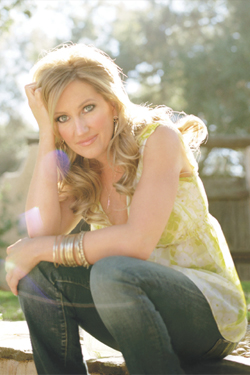Lee Ann Womack Hails Classic Influences On New Album
By Bobby Reed
Lee Ann Womack is pushing her career forward by taking a look back. As the title suggests, Womack's new album, There's More Where That Came From, is heavily influenced by classic Country Music of the '60s and '70s.
Critics have fawned over the album, and radio programmers warmly embraced the lead single, "I May Hate Myself in the Morning," which added another Top 10 single to her career list that includes "You've Got to Talk to Me," "The Fool,'' "A Little Past Little Rock" and "Ashes by Now."
Womack is best known for "I Hope You Dance," a song that topped the Country charts and crossed over to become a hit on the pop and adult contemporary charts. This unforgettable anthem was a key factor in helping Womack win CMA Female Vocalist of the Year in 2001.


August 23, 2005
© James Minchin III

© James Minchin III
Womack stayed out of the spotlight for most of 2004 in order to focus on her family. Womack is married to producer and song publisher Frank Liddell, whose production credits include albums by Jack Ingram and Miranda Lambert. Womack has two daughters, Anna Lise, 6 (with Liddell), and Aubrie, 14 (with singer-songwriter Jason Sellers).
Womack explained how a demo recording of Odie Blackmon's composition "I May Hate Myself in the Morning" jolted her out of a professional respite.
"I was kind of languishing, not really sure what I wanted to do or what I needed to do," she recalled. "But then I heard 'I May Hate Myself in the Morning,' and that was my answer. To put it in visual terms, it was like I had a big question mark over my head, and then all of the sudden, I had a big light bulb over my head. That song made me want to get back in the studio and make music again.''
The song gave direction to the resulting album, and it became Womack's highest-charting single since 2000. "I knew from the beginning that I wanted 'Hate Myself' to be the first single," Womack said. "That song was not really like the other things that were happening on radio at the time, but at some point, you just have to stand up and say, 'This is who I am.' I felt that I needed to make sure people understood that."
The song's lyrics - concerning a character who can't resist spending time with an old flame - resonated with fans. "The listener response was immediate, and mostly
from women who have been in the same situation and could relate to the song,'' said Lisa Dent, the midday personality at WUSN/Chicago.
In addition to doing her own songwriting, Womack listened to approximately 1,000 songs in anticipation of entering the studio.
"I listened to songs over a long period of time for this album," Womack said. "My husband is a publisher, and all of our friends are plugged into the songwriting community, so listening to songs is a process that never stops for us. The day I finished this album, I was already putting songs aside and listening for the next album."
For her seventh release, Womack enlisted the services of producer Byron Gallimore (Faith Hill, Tim McGraw, Randy Travis). Gallimore produced a dozen of the new album's 13 cuts, including the single, "He Oughta Know That by Now." (Greg Droman produced the track "When You Get to Me.")
"A lot of people were shocked that I was working with Byron," Womack said. "But to me, the mark of the great producers is that they make the artist's album, not their album. It's not the producer's sound; it's the artist's sound. Byron was the perfect choice because I knew he would do what I wanted him to do."
During the recording sessions, Womack and Gallimore had many discussions about Country Music classics. "I would bring Byron albums that I loved," Womack recalled. "I would say, 'Let me tell you why I like the way Buck Owens and Don Rich sound together here.' I'd tell him why I like the harmonies on a particular song, or why I like the bass on a Ricky Skaggs album. Then Byron would say, 'Well, here's how they achieved that then, and with today's technology, here's how we can achieve it on your album.' I think Byron is so talented, and he's such a great listener."
Gallimore has certainly proven that he has the Midas touch, but his philosophy as a producer is to let the artist guide the way.
"It's not a situation where you want to take the artist off of the path that he or she wants to go,'' Gallimore explained. "My job is to assist the artist. Lee Ann had tons of suggestions throughout the recording of this album. So we worked together as a team, and I think that's what it takes. At the end of the project, it's about both of us being happy, but it's really about her being proud of the album that she has in her hand - and not feeling like there's any little piece in any song that she would like to change. We carried it to that degree.''
Womack is promoting the album by participating in one of the summer's biggest tours, performing in the middle slot on a bill with superstar Toby Keith and newcomer Shooter Jennings.
Womack is now an industry veteran, but she is still breaking new ground. MCA Nashville recently issued her Greatest Hits collection in the new DualDisc format, with audio tracks on the CD side and music videos on the DVD side. Womack is one of the first Country artists to have a product available in this format.
On the Web: www.leeannwomack.com
© 2005 CMA Close Up News Service / Country Music Association, Inc.